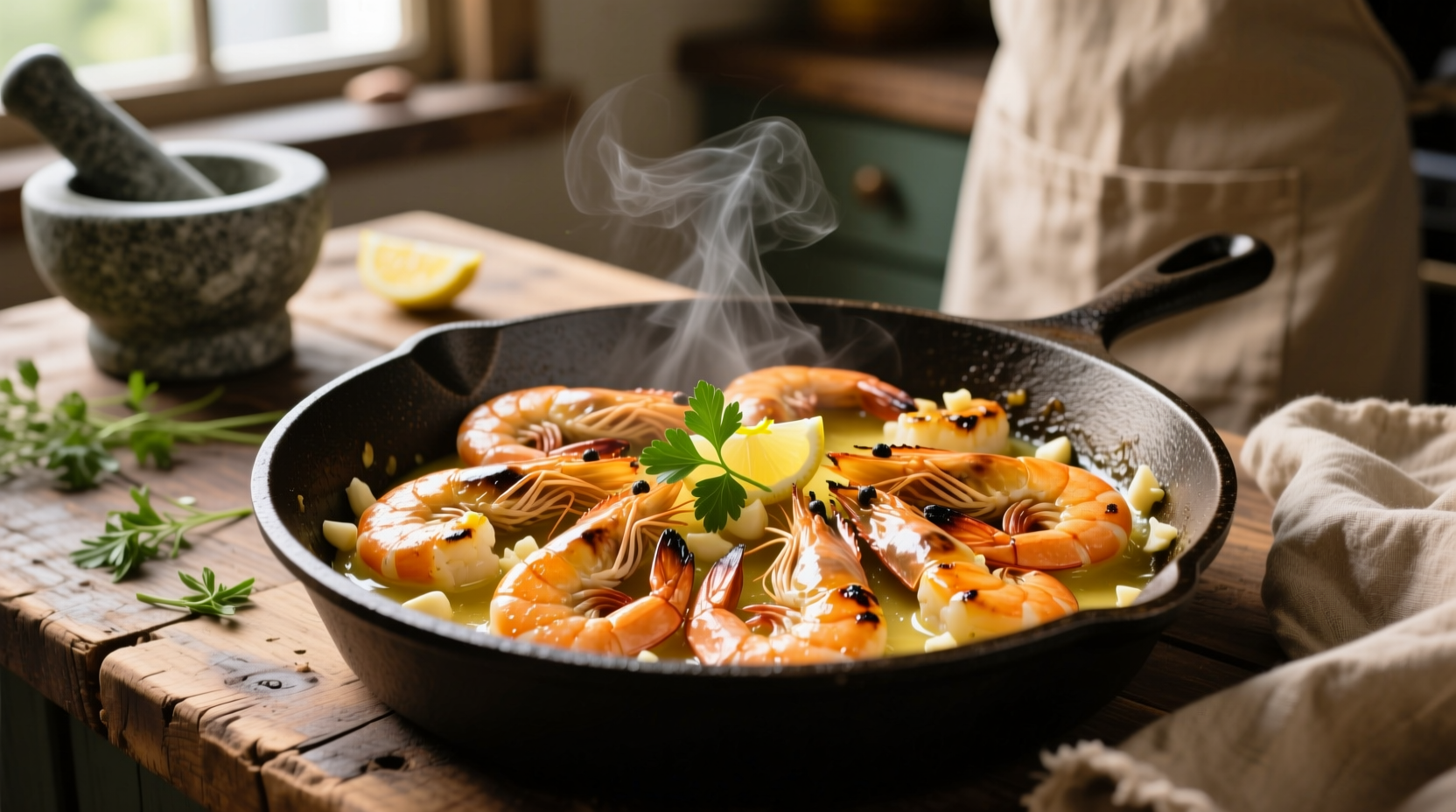There's nothing quite like the aroma of shrimp sizzling in butter and garlic filling your kitchen. This simple yet elegant dish transforms humble ingredients into a restaurant-quality meal faster than delivery arrives. As a professional chef who's cooked this dish thousands of times across Michelin-starred kitchens and home stoves, I've perfected the precise timing and technique that separates rubbery disappointment from tender perfection.
Why This Method Works Every Time
The magic happens through controlled heat application. Shrimp contain delicate proteins that overcook in seconds, while garlic burns at temperatures above 325°F. Our method solves both problems by starting with cold butter in a preheated pan, creating an automatic temperature buffer that keeps garlic safe while cooking shrimp to ideal tenderness.
| Shrimp Size | Cooking Time | Internal Temp | Texture Indicator |
|---|---|---|---|
| U/10 (Jumbo) | 2–2.5 min/side | 140–145°F | Opaque with C-shape |
| 16–20 count | 1.5–2 min/side | 140–145°F | Firm but yielding |
| 21–25 count | 1–1.5 min/side | 140–145°F | Translucent center gone |
This cooking timeline follows USDA Food Safety and Inspection Service guidelines for seafood preparation. Proper internal temperature ensures food safety while maintaining optimal texture (USDA FSIS).
Essential Ingredients Checklist
- Shrimp: 1 lb (16-20 count) raw, peeled and deveined (thawed if frozen)
- Butter: 4 tbsp unsalted (European-style for richer flavor)
- Garlic: 4 large cloves, finely minced (about 2 tbsp)
- Acid: 1 tbsp fresh lemon juice
- Seasoning: ½ tsp sea salt, ¼ tsp black pepper, pinch of red pepper flakes
- Herb: 2 tbsp fresh parsley, finely chopped
Professional tip: Never use pre-minced garlic from jars. Fresh garlic contains allicin enzymes that create complex flavor compounds when cut, while pre-minced versions contain preservatives that create bitter off-flavors when cooked (National Center for Biotechnology Information).
Step-by-Step Cooking Process
Preparation Phase (5 minutes)
- Pat shrimp completely dry with paper towels – moisture is the enemy of proper searing
- Mince garlic finely (not crushed) to maximize surface area without burning
- Prepare all ingredients before heating pan – this cooks too fast to multitask
Cooking Phase (5 minutes)
- Heat 12-inch skillet over medium-high until water droplets sizzle (about 2 minutes)
- Add butter and immediately reduce heat to medium-low as it melts
- Add garlic and cook 30 seconds until fragrant but not colored
- Arrange shrimp in single layer, cook 1.5-2 minutes until bottom turns pink
- Flip shrimp, cook 1-1.5 minutes until opaque throughout
- Remove immediately from pan to prevent carryover cooking
- Stir in lemon juice and parsley, season to taste

Critical Success Factors
Most home cooks make these three preventable mistakes:
- Overcrowding the pan: Causes steaming instead of searing. Cook in batches if necessary.
- Burning garlic: Garlic burns at 325°F while shrimp need 350°F for searing. Solution: Add garlic to melted butter immediately to lower effective cooking temperature.
- Overcooking shrimp: Shrimp continue cooking off-heat. Remove at 140°F internal temperature for perfect 145°F finish.
Serving Recommendations
This dish shines when served immediately over:
- Fresh linguine with reserved cooking water to create light sauce
- Crusty bread for soaking up the garlic butter
- Simple arugula salad with lemon vinaigrette
Wine pairing: A crisp Sauvignon Blanc or unoaked Chardonnay complements the buttery richness without overwhelming delicate shrimp flavor.
Storage and Reheating Guidelines
While best served fresh, leftovers can be stored:
- Refrigerate within 2 hours in airtight container (max 2 days)
- Reheat gently in skillet with 1 tsp water to recreate steam environment
- Never microwave – causes rubbery texture
- Do not freeze cooked shrimp – texture deteriorates significantly
Common Variations
- Creole style: Add 1 tsp smoked paprika and ¼ tsp cayenne with garlic
- Mediterranean: Substitute lemon juice with 2 tbsp white wine and add capers
- Dietary adaptation: Replace butter with ghee for dairy-free version
- Restaurant technique: Finish with splash of cognac for complex depth
Frequently Asked Questions
Can I use frozen shrimp for butter garlic shrimp?
Yes, but proper thawing is critical. Place frozen shrimp in a colander under cold running water for 10-15 minutes until flexible but still cold. Never cook frozen shrimp directly – the exterior will overcook before interior thaws.
Why does my garlic butter shrimp turn out rubbery?
Rubbery texture indicates overcooking. Shrimp proteins tighten rapidly above 145°F. Remove shrimp from heat at 140°F internal temperature as carryover cooking will raise it 5 degrees. Cooking time should never exceed 3 minutes total for medium-sized shrimp.
How can I prevent garlic from burning in butter?
Add minced garlic to melted butter immediately after butter foaming subsides, then reduce heat to medium-low. The butter's water content creates a natural temperature buffer keeping the mixture below 200°F – well below garlic's burning point of 325°F.
What's the best shrimp size for sautéing in butter?
16-20 count shrimp (about 1.5 inches long) provides the ideal balance of cooking speed and meaty texture. Larger shrimp risk uneven cooking, while smaller ones overcook before developing flavor. Always choose wild-caught when possible for superior flavor and texture.











 浙公网安备
33010002000092号
浙公网安备
33010002000092号 浙B2-20120091-4
浙B2-20120091-4